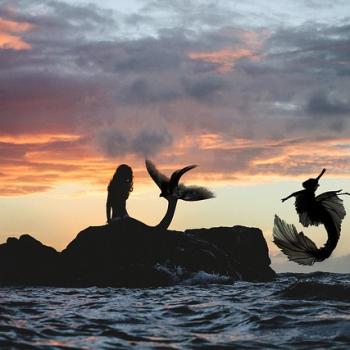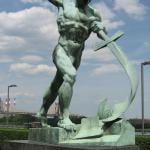
Disney’s Frozen is unlike other “princess” movie in that it is not as much a tale about courtship, but of sisterly love. Sure, intertwined within the main plot is a somewhat predictable triangle of romance, but the primary theme is not like most enchanted fairy tales. There is much more going on here.
The story begins by introducing two young sisters. Elsa, the eldest, possesses the power to create magical ice. This magic has the potential to create many beautiful shared memories with her younger sister, Anna. However, it also has the potential to do great harm. The girls discover this one fateful evening.
After Anna is struck in the head by Elsa’s ice, the royal parents rush the girls off to a magical troll—a shaman of sorts. The elder gives the family the advice that Elsa must A) Control her powers as they will certainly grow and B) Fear will be her biggest enemy. So what do Elsa’s parents do? They instill paralyzing fear in her, hiding her from everything she once loved, including Anna. Talk about an adventure in missing the point.
Tragedy strikes the girls when their parents are lost at sea. The two sisters are left with only each other, which is a relationship that has become merely a shell of its former self. Elsa’s powers have indeed grown, but fear, loss, and heartache are the driving force. Inevitably, everything will come to a head during Elsa’s coronation.
As the masses gather for the coronation of the new queen, we are introduced to an underlying theme that will remain throughout the film. Arendelle, the locale where the story takes place, is a quaint and bustling town. There seems to be no blight, no poverty (a la Aladdin’s Agrabah), and no crime. Because of this however, there seems to be a growing interest from the Duke of Weselton, who appears to be an oligarchist.[1] The stage will soon be set: either Arendelle will continue in her peaceful and prosperous ways or her riches will be exploited by the powerful elite who desire such things. Either Arendelle will resemble the kingdom of God or yet another kingdom of man—New Jerusalem or Babylon.
During this time, Anna, who has been desperate for relationship for years, falls in “love” the moment she meets a handsome and charming prince named Hans. This news becomes too much to bear for Elsa, who, because of her deep-rooted fear, could barely make it through her own coronation. This sets off a chain of events that will forever change the sisters and the kingdom. Years of pain, suffering, and torment explode from Elsa the minute Anna demands an explanation as to why she and Hans cannot marry. A fury of ice covers the great dance hall and in an instant, Elsa is seen not as a beautiful queen, but as a monster—a sorceress. In a very real way, she resembles the many scapegoats throughout history—those whom society fears, but knows not quite why. Surely, she must flee for her life. (Luke 4:30)
Nearly every American parent knows what happens when Queen Elsa ascends to the top of the North Mountain. (I don’t need to point to how many plays “Let it Go” has on YouTube.) There are two themes this epically famous song has. First, Elsa recognizes that she is being scapegoated by the community when she sings the lyric, “A kingdom of isolation and it looks like I’m the queen.” Yes, she is the queen of Arendelle. But this is a play on words—she is the queen of a kingdom of isolation—a kingdom of one. She is the one the “all” are against. Second, when she sings the lyric, “be the good girl you always have to be”, she is displaying the impossibility of living under the system she was placed, which was a rigid system of rules and regulations forced upon her by her parents. She was forced to withdraw from all loving relationships, and it drove her to the most extreme fringes of society. The end-game of this unfortunate lifestyle was her lonely climb up the mountain.
When Anna goes after her sister Elsa, she puts her own life on the line. That is what true love does; or as Olaf, a magical snowman from Elsa and Anna’s youth, will later say: “love is putting the needs of others before yourself.” Anna models just what one will go through to find that which was once lost.[2] Neither wolves nor near hypothermia was going to stop her from finding Elsa. When she and new friends, Kristoff and Olaf, reach Elsa’s new ice castle, they are not met with the kindness Anna had hoped. Elsa’s magic—manifested again as fear—strikes Anna’s heart and again, any relationship with Elsa seems hopeless. The three friends are evicted from the “kingdom of isolation” by an enchanted snow monster and forced back down the mountain. Because of Anna’s icy injury, Kristoff rushes her to his “family,” which happens to be the very same troll from Anna’s youth.
The wise old troll who once cured Anna teaches that because fear, Elsa’s great enemy, was what caused Elsa to strike Anna, only love then can reverse the effects to Anna’s heart. Anna knows what she must do: find Hans for a “true love’s kiss.” The friends rush back to Arendelle and Anna finds herself in the arms of Hans just in time. However, Hans had other plans all along. Like many before him, he had been seduced by power. His goal was to lord over the wealthy kingdom of Arendelle and saw Anna as his way to the crown. He betrays Anna and leaves her to freeze to death, charging her sister Elsa—who had been captured while Anna was with the trolls—with her murder in the process.
In the final dramatic scene of the movie, all major characters are present. While Kristoff rushes back to Arendelle after realizing how much he loves Anna, both Elsa and Anna escape their respective captivity. Hans, however, is there to meet Elsa to in hopes that he can deliver a fatal blow. In the midst of the ever-growing blizzard, Anna, who is nearly dead at this point, has one final choice to make. Kristoff, her true love, is within her grasp, but so too is Hans and his deadly blade. Anna, in an act of self-sacrificial love, offers her life for Elsa’s and jumps in front of Hans. In doing so, she finally freezes solid, deflecting Hans’ sword. When Anna does this, time seems to nearly stand still as she takes what appears to be her final breath.
Just when Anna seems lost, she begins to thaw and life begins flowing through her again. In her act of true love, all fear is cast out. (1 John 4:18) For years, Elsa lived in perpetual fear, but in one act of righteousness (Romans 5:18), all fear dissolves. Or, as Olaf would put it: “true love will thaw a frozen heart.” When Elsa’s revelation takes hold; the blizzard that engulfed the kingdom lifts and life returns. The two great evils, Hans and the Duke of Weselton, are banished from the city. Instead of falling into the hands of those who would see her resemble Babylon, Arendelle falls back into the care of the two sisters who would have her resemble New Jerusalem. The love Anna showed her sister Elsa was the greatest gift one could possibly give; or, as Jesus would say: “Greater love hath no woman than this, that a woman lay down her life for her friends.” Amen to that.
[1] Oligarchy: a small group of people having control of a country, organization, or institution.
[2] The Greek verb apollumi translates to “to destroy or perish” and is the verb used to describe the prodigal son who perished but was found (Luke 15:11–32) and the lost sheep who perished but then was found (15:1–7).













